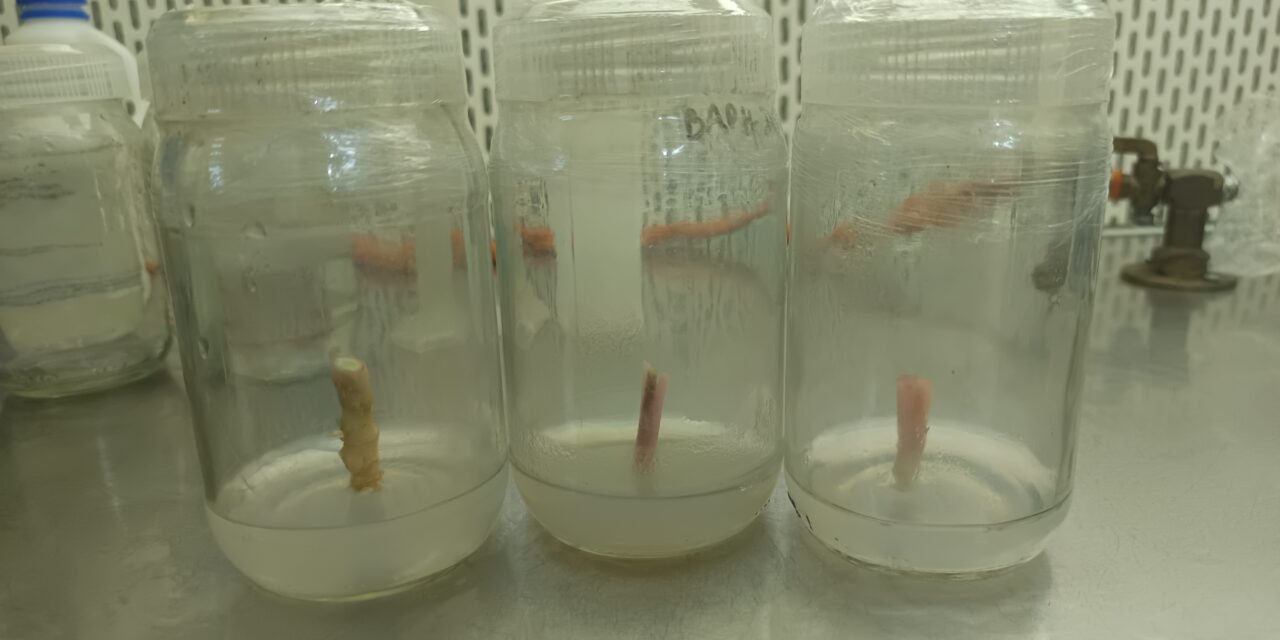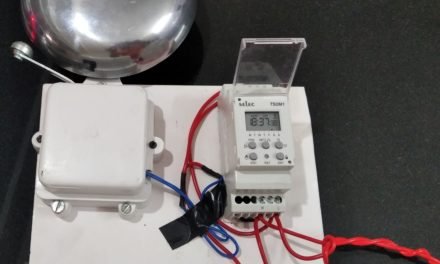INTRODUCTION :- Aglaonema Red Siam is a popular decorative plant with bright red and green leaves. It belongs to the Araceae family and is often used for indoor decoration because of its beautiful colors. It is also in high demand in plant nurseries and garden design. But growing it the usual way, like using stem cuttings, is slow and doesn’t produce many new plants. That’s why plant tissue culture is a better method—it helps grow many healthy plants quickly in a short time.
EXPLANT CAN USE :-
Shoot tips
Stem nodes
Leaf segments
STAGES :-
Preparation of Explant
Initiation
Shoot Multiplication
Rooting
Hardening/Acclimatization
MATERIALS :-
| Beaker | Test tube |
| Conical flask | Scissors |
| Petri plate | Test tube stand |
| Measuring cylinder | Distilled water |
| Culture bottle | Sterile distilled water |
| Cotton plug | Tissue paper |
| Forceps | Filter paper |
| Spatula | Autoclave bag |
| Scalpel | Surgical sterile blade |
CHEMICALS FOR STERILIZATION :-
| Liquid soap |
| Savlon ( Dettol ) |
| Ethanol |
| Sodium hypochlorite |
| Antibiotics |
CHEMICALS FOR MS MEDIA :-
| Macronutrients |
| Micronutrients |
| Vitamins |
| Iron Source |
| Mesoinositol |
| Sucrose |
| Agar |
| Hormones |
| HCl / NaOH |
PREPARATION OF MACRONUTRIENTS :-
| Macronutrients | Original Concentration mg/l | Amount of salt after multiplying original concentration by 20X, Solution Volume (250ml) |
| NH4NO3 | 1650 | 8250mg |
| KNO3 | 1900 | 9500mg |
| KH2PO4 | 170 | 850mg |
| MgSO4.7H2O | 370 | 1850mg |
| CaCl2.2H2O | 440 | 2200mg |
PREPARATION OF MICRONUTRIENTS :-
| Micronutrients | Original Concentration mg/l | Amount of salt after multiplying original concentration by 100X, Solution Volume (250ml) |
| H3BO3 | 6.2 | 155mg |
| MnSO4.4H2O | 22.3 | 557.5mg |
| ZnSO4.7H2O | 8.6 | 215mg |
| Na2MoO4.2H2O | 0.25 | 6.26mg |
| CoCl2.6H2O | 0.025 | 0.625mg |
| CuSO4.5H2O | 0.025 | 0.625mg |
| KI | 0.83 | 20.75mg |
PREPARATION OF VITAMINS :-
| Vitamins | Original concentration (mg/l) | Original Concentration multiplying by 1000X, Final solution volume (50ml) |
| Thiamine HCl | 0.1 | 5mg |
| Pyridoxin HCl | 0.5 | 25mg |
| Nicotinic | 0.5 | 25mg |
| Glycin | 2.0 | 100mg |
PREPARATION OF IRON SOURCE :-
| Iron Source | Original concentration (mg/l) | Original Concentration multiplying by 400X, Final solution volume (50ml) |
| FeSO4.7H2O | 27.8 | 2780mg |
| Na2EDTA.2H2O | 37.3 | 3730mg |
PREPARATION OF MS MEDIA :-
| Materials | Final Volume ( 250ml ) |
| Macronutrients | 12.5ml |
| Micronutrients | 0.625ml |
| Vitamines | 0.625ml |
| Iron source | 0.250ml |
| Mesoinositol | 25mg |
| Sucrose | 7.5gm |
| Agar | 2gm |
| Distilled water | 100ml |
MESOINOSITOL:-
When we prepare 1 litre ms media then we will take 100mg mesoinositol.
SUCROSE (3%):-
When we prepare 1 litre ms media then we will take 30gm sucrose.
PREPARATION OF HORMONES:-
BAP Stock:– 100mg BAP in conical flask (250ml) dissolve with ethanol or 1M NaOH solution and BAP powder dissolve completely in solution and make final volume 100ml solution with Distilled water.
IBA Stock:- 100mg of IBA in conical flask (250) dissolve with ethanol or 1M NaOH solution and IBA powder dissolve completely in solution and make final volume to 100ml with Distilled water.
pH CHECK:- Prepare solution media pH range is 5.8 – 5.9 by using HCl or 1M NaOH.
Agar:- Take 8 gm agar powder and add in media ,mix with glass rod then in microwave the media for 14 minutes and agar dissolve completely in media.
STERILIZATION PROCESS :-
Autoclave the used media to sterilize it before disposal. Discard the used media from the culture bottle. Soak the empty culture bottle in chromic acid (for cleaning or decontamination) for 24 hours. After 24 hours, remove the culture bottle from the chromic acid and wash it with liquid soap. Then dry it in a hot air oven at 180°C for 12 hours. Then we have wrapped glassware in autoclave bag then put in autoclave with distilled water and culture media.
Autoclave work at high pressure and temperature ( 15 psi, 121°C) for 15 to 20 minutes and kill the microorganisms. After sterilization removed glassware from sterilizer. And placed in laminar air flow then when we use it, we will turn8 on UV – ray light for 1 hour.
METHODOLOGY :-
14 June 2025
1. Select mother plants ( Shoot tips, Nodal part ) that are young shoot tips disease-free, and have high-yield and desirable traits.
2. Cut the mother plant in desirable shape and placed dry tray.
3. Wash the cut explant in running water for 15 minutes.
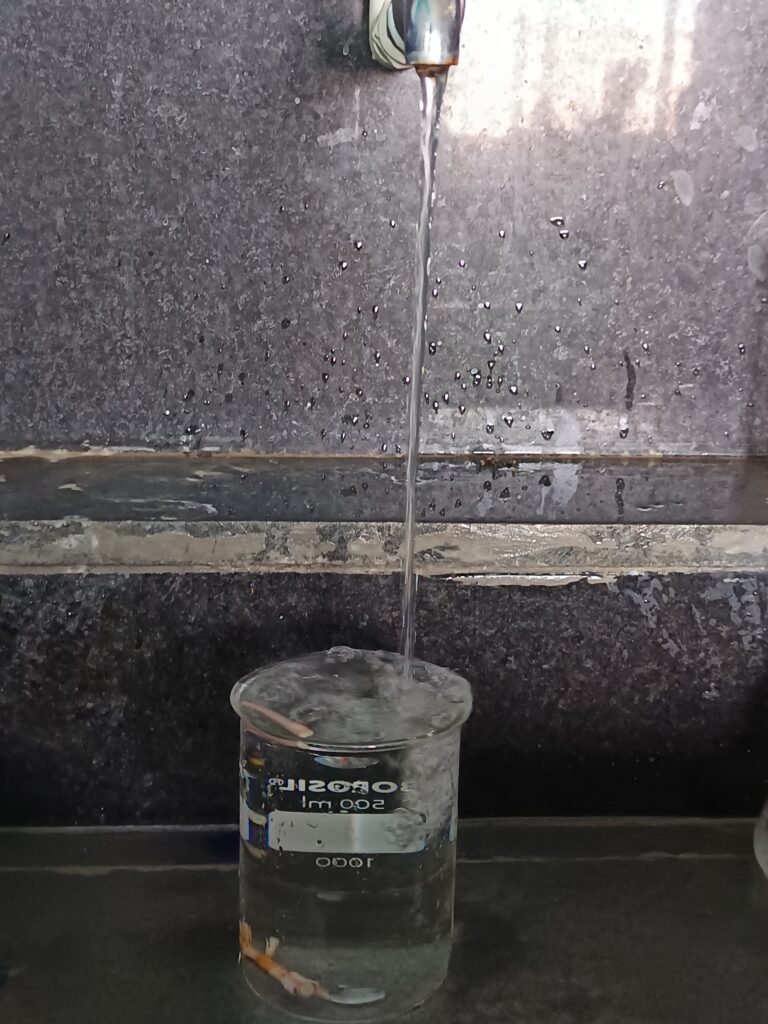
4.Handle the plant material with sterile gloves.
5. Then prepare total volume 300ml soap solution (30ml soap liquid and 270ml distilled water).
6. Wear glove hand and wash the plant material for 5 minutes.
7.Then remove the soap solution and placed in glass beaker.
8. Cut the material desirable size with the help of knife.

9. Then soak the material in savlon solution ( 3ml savlon and 300 ml distilled water) for 15 minutes.

10. Then wash the plant material from sterile distilled water 3 to 5 time in bottle beaker.
11. Prepare 4% sodium hypochlorite solution and taking sodium hypochlorite solution into a laminar air flow and soak the plant material in sodium hypochlorite solution for 20 minutes( for 1 jar 10ml sodium hypochlorite and 250ml sterile distilled water).

12. After 20 minutes then remove plant material from sodium hypochlorite solution and wash the plant material 3 to 5 times in sterile distilled water.
13. Then cut the plant material required culture bottle size with the help of knife on sterilized brown paper.
14. Prepare antibiotic solution using Cefotaxime antibiotic( 1ml antibiotic and 200ml sterile distilled water) and soak the plant material in this solution for 30 minutes. Using only fresh antibiotic solution.
15. Then inoculate the plant material in culture medium( bottle beaker) and remove laminar air flow placed inoculate culture bottle at 24°C with photo periods of 6 to 7 hours light and 8 hours darkness for tissue culture sterile environment.

RESULT :-
After one week, the inoculated Aglaonema Red Siam explants showed no growth and were contaminated.
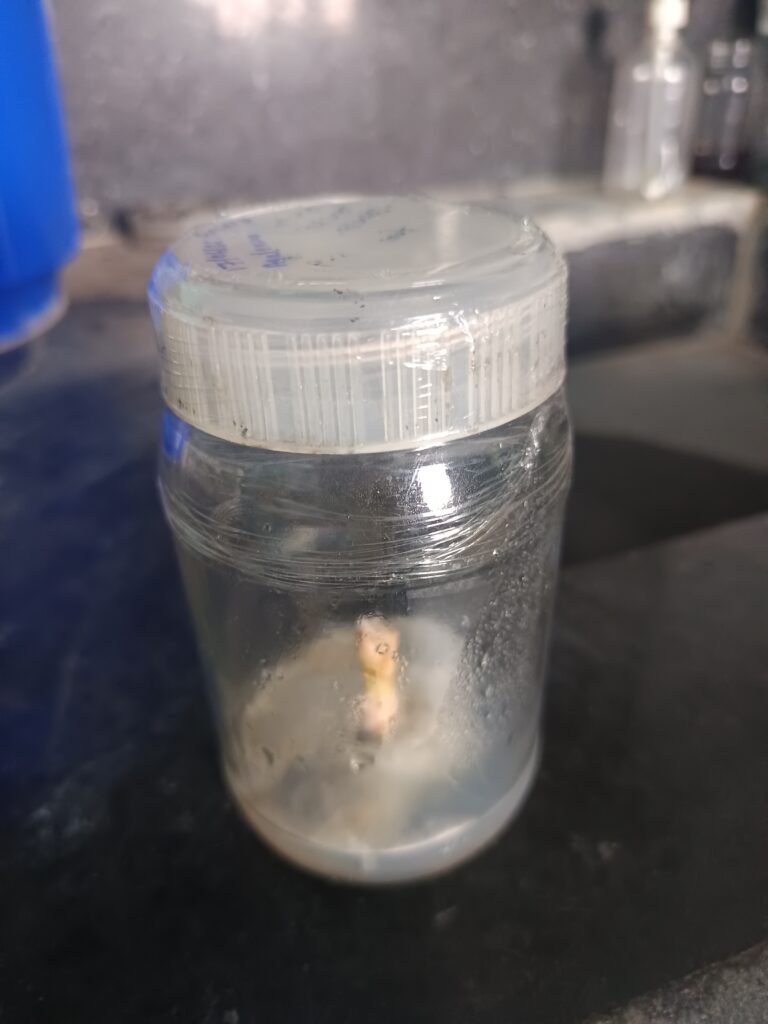
16 June 2025
Cleaned the culture bottles, prepared the MS medium, and autoclaved the MS medium, glassware, and distilled water.
17 June 2025
I again took young shoot tips, nodal segments of aglaonema red siam and inoculated them using the same process. And some contamination appeared after a few days.


20 June 2025
I discussed with Dixit sir the problem of Aglaonima red siam getting contaminated sir suggested the entire plant needs to be soaked in sodium hypochlorite solution for 20 minutes, then washed 3 to 5 times. Next, cut the plant to the proper size and expose it to UV light under running tap water, followed by surface sterilization and soak plant in sodium hypochlorite solution for 30 minutes, and finally, inoculate it into MS culture bottles.
21 June 2025
Cleaned the culture bottles, prepared the MS medium, and autoclaved the MS medium, glassware, and distilled water.
22 June 2025
The whole plant was soaked in sodium hypochlorite solution for 20 minutes ( in 500ml distilled water 15ml sodium hypochlorite).

Then washed 3 to 5 times and cut the plant to the proper size and expose it to UV light under running tap water for 15 minutes.
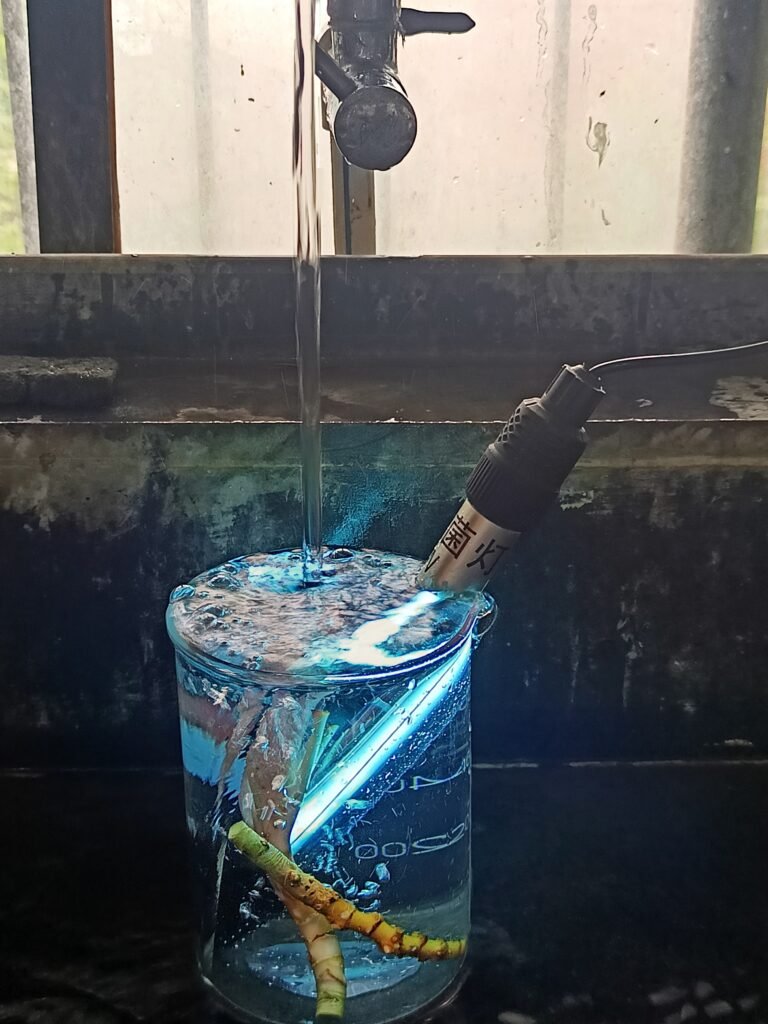
Then after that, surface sterilization of the explant is done, and some changes are made in the surface sterilization process, such as keeping sodium hypochlorite for 30 minutes.And then the explant was inoculated into MS media.
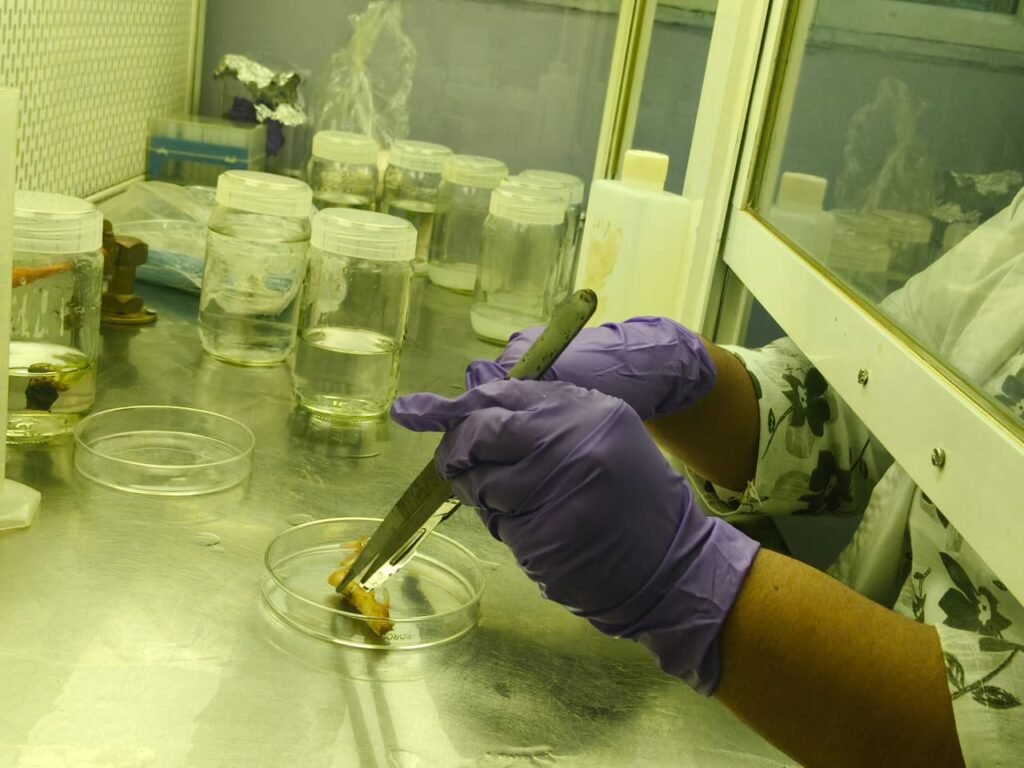

Result :-
After one week, the Aglaonema Red Siam plant got contaminated.
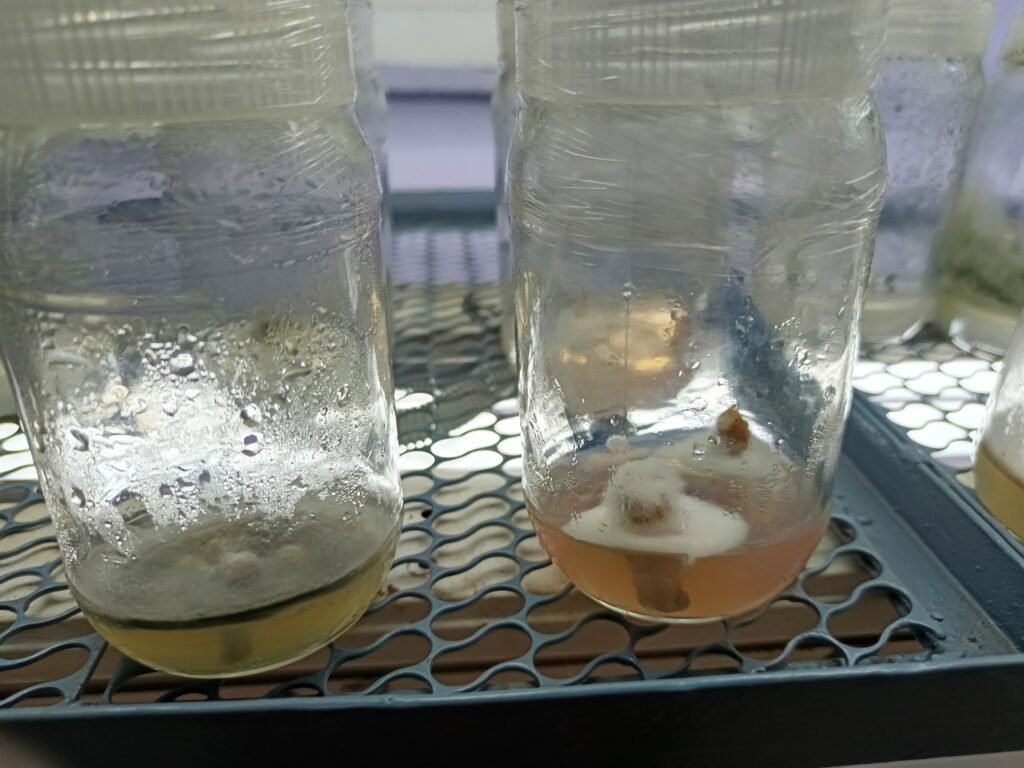
30 June 2025
I had another discussion with Dixit sir about the infection problem, and he told me that I’m using a low quantity of sodium hypochlorite in the sodium hypochlorite solution in the first step. He advised me to increase the quantity and keep the rest of the process the same.
4 July 2025
The whole plant was soaked in sodium hypochlorite solution for 20 minutes ( in 500ml distilled water 150ml sodium hypochlorite).
Then washed 3 to 5 times and cut the plant to the proper size and expose it to UV light under running tap water for 15 minutes. Then after that, surface sterilization of the explant is done, and some changes are made in the surface sterilization process, such as keeping sodium hypochlorite for 30 minutes. And then the explant was inoculated into MS media.
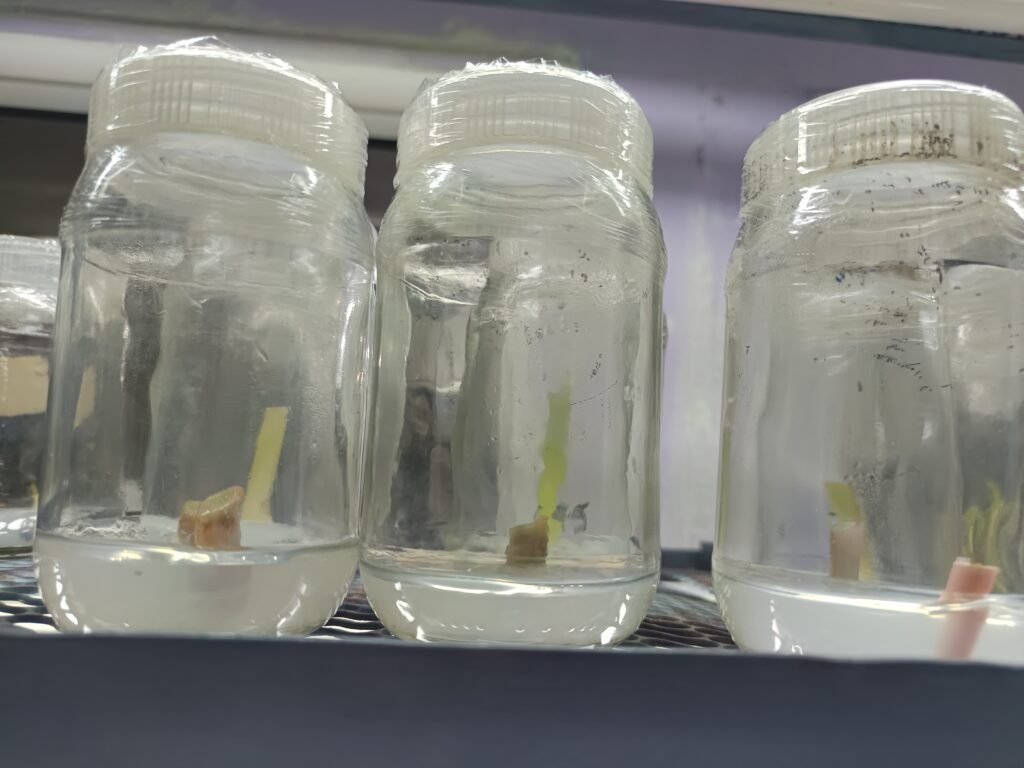
Result :-
Contamination appeared within 5 days after inoculation.
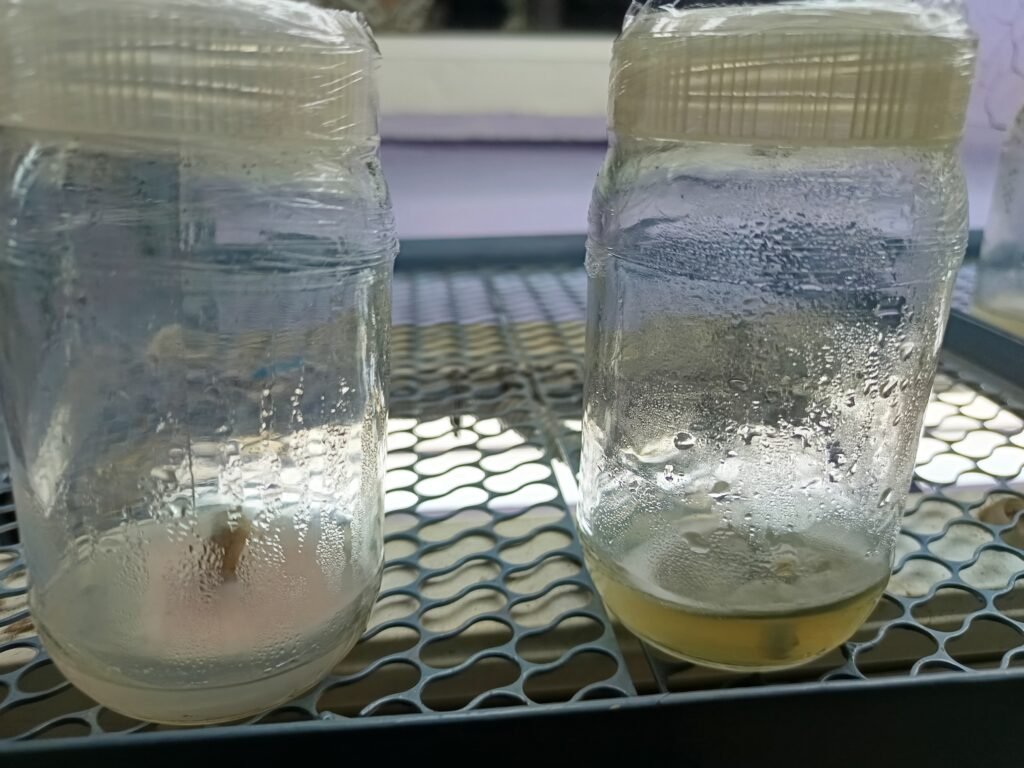
9 July 2025
We take explants of Aglaonema plants and wash them under running water exposed to UV light for 15 minutes. Then, the explants are soaked in a sodium hypochlorite solution for 40 minutes, followed by surface sterilization. After that, the explants are soaked in an antibiotic solution (200 ml distilled water and 2 ml antibiotic) for 30 minutes, and then inoculated onto MS medium.

Result :-
Again, contamination appeared within 5 days.

14 July 2025
After discussing with Dixit Sir, I grew Aglaonema and Napier grass in a hydroponic setup and treated it with fungicide and UV light.

18 July 2025
I took a explant from a hydroponic setup, perform surface sterilization, and then inoculated it.
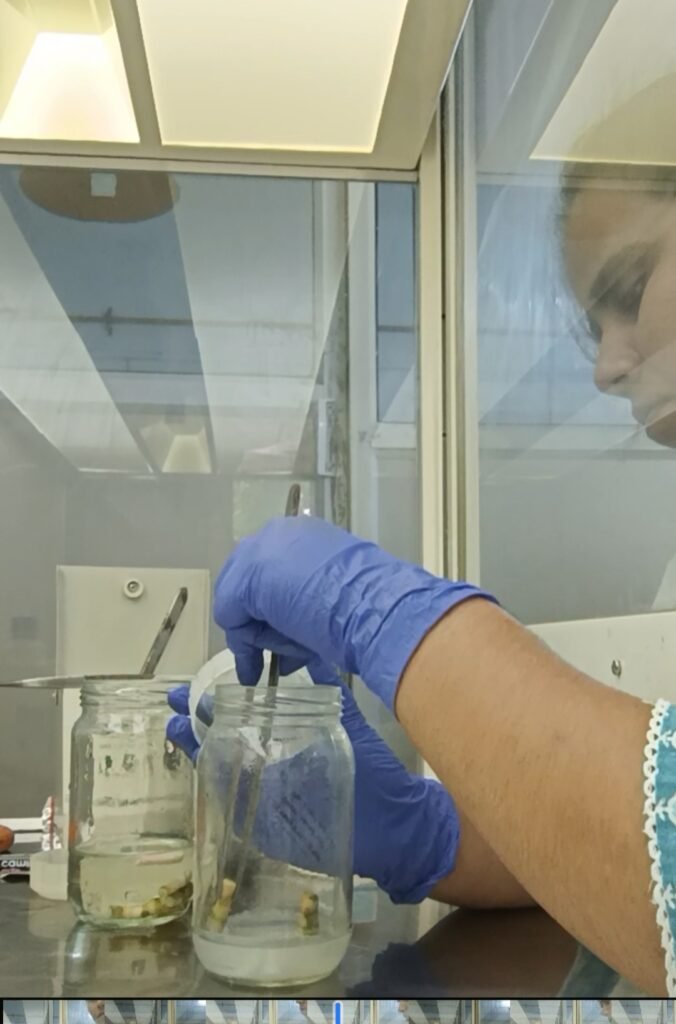
Result :-
After inoculation, contamination appeared in some bottles within 6–7 days, and one bottle showed contamination within 15 days.
23 July 2025
I took an explant of Aglaonema from a hydroponic setup, performed surface sterilization, and then inoculated it onto MS medium.
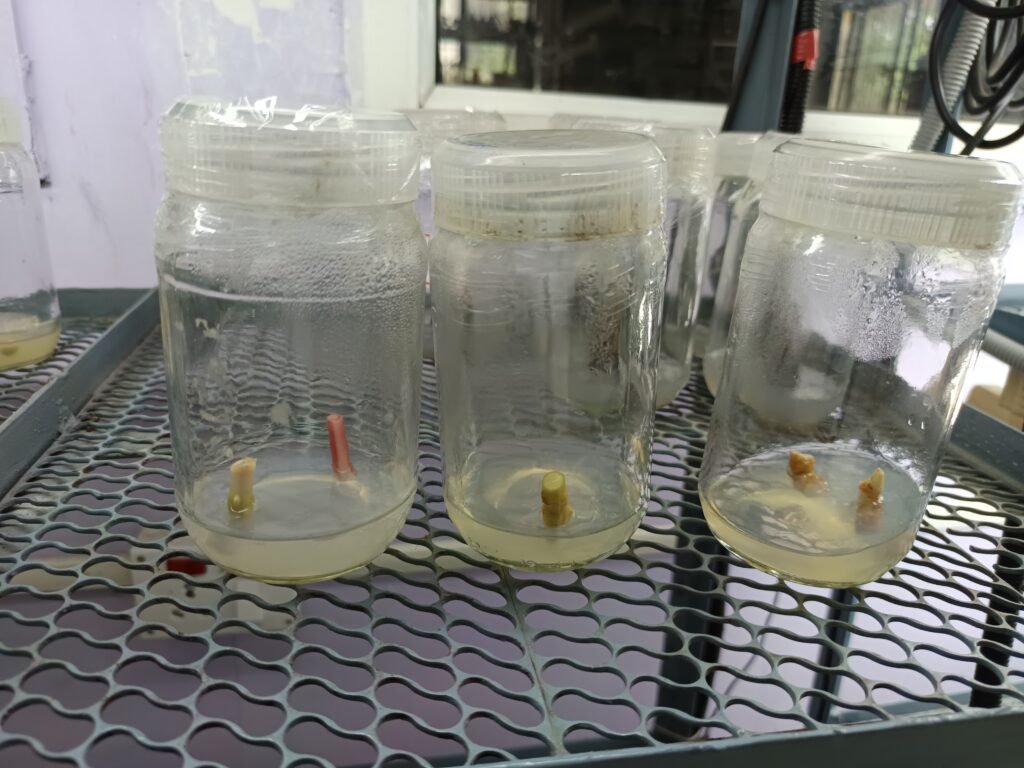
Result :-
Contamination appeared within one week.
3 August 2025
I followed the same process as before — I took an explant from the hydroponic setup, performed surface sterilization, and carried out inoculation.
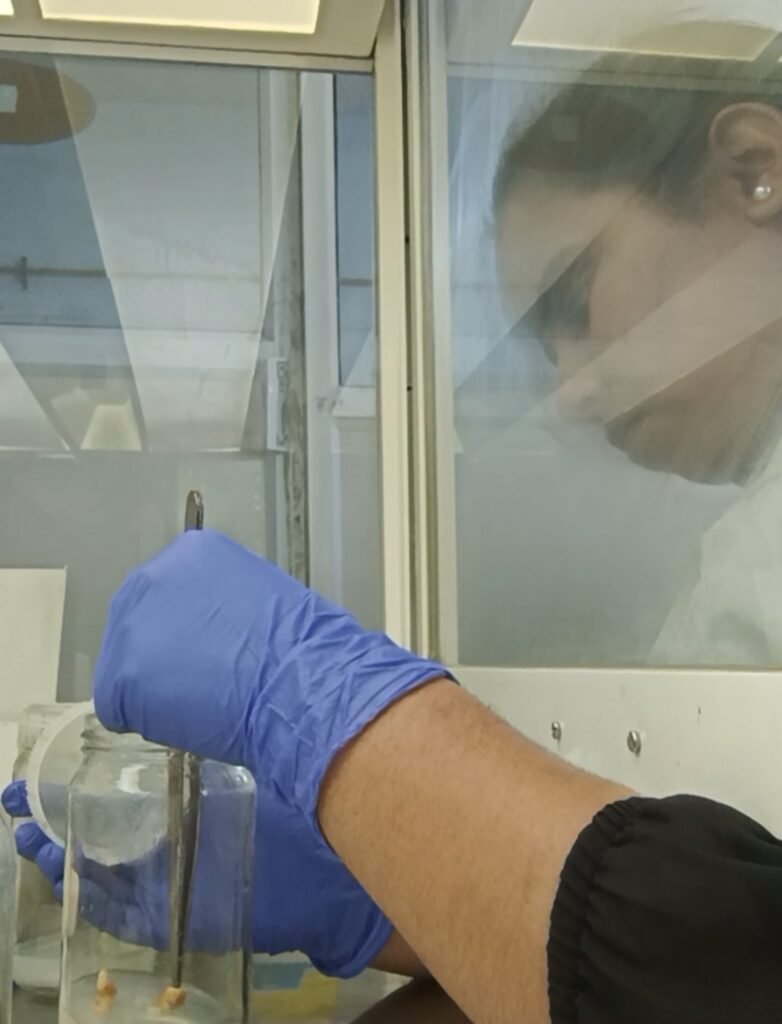
5 August 2025
I followed the same process as before. Inoculate the explant of Aglaonema into the culture bottle.
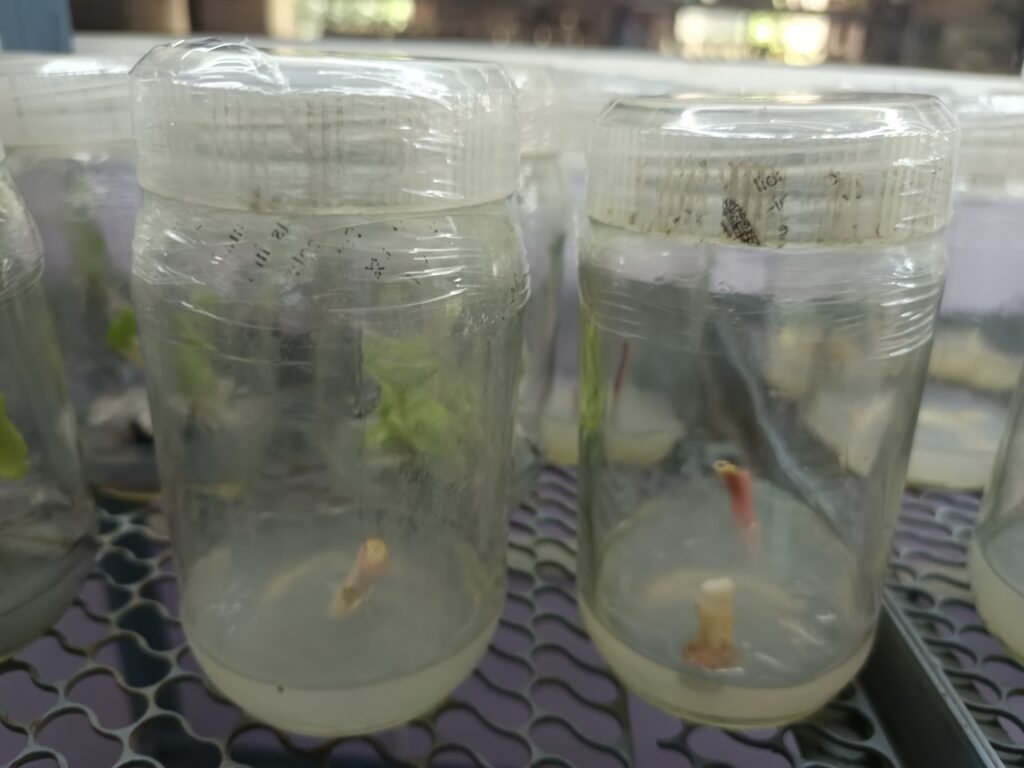
8 August 2025
I took an explant of Aglaonema from a hydroponic setup, performed surface sterilization, and then inoculated it onto MS medium.
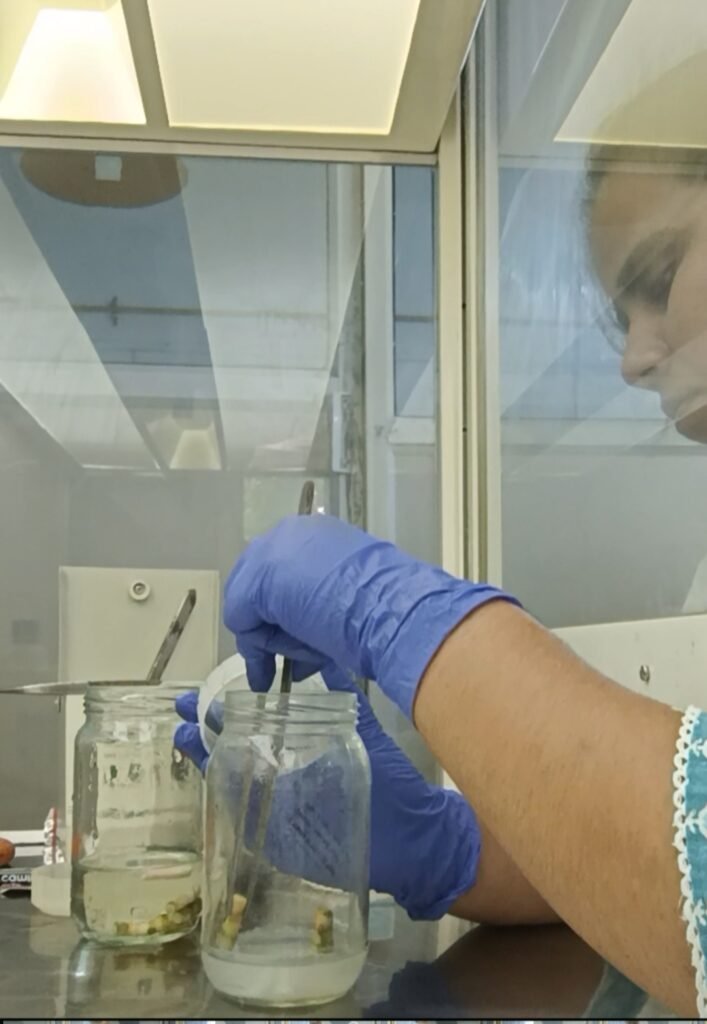
11 August 2025
I took an explant from hydroponics, performed surface sterilization, and then inoculated it.
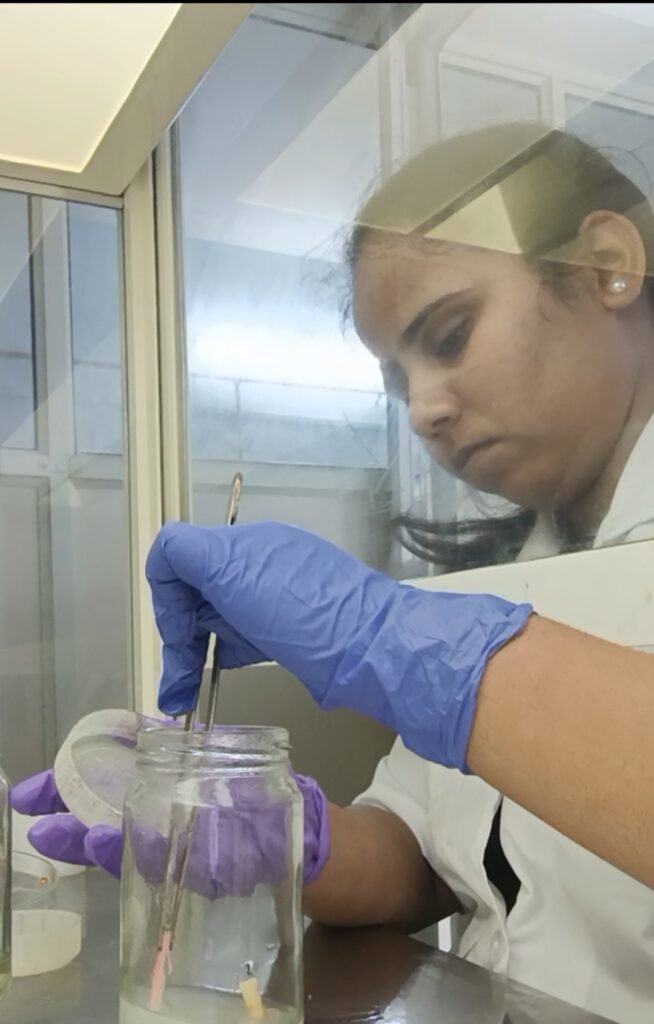
18 August 2025
I again took a explant from a hydroponic setup, perform surface sterilization, and then inoculated it.

19 August 2025
I discussed with Dixit Sir about the contamination problem in Aglaonema plants, and he suggested that the Aglaonema plants grown in hydroponics should be washed with 1% sodium hypochlorite solution, the water should be changed daily with dosing, and UV light should be used in the hydroponic setup.
22 August 2025
I took the plants from the hydroponic setup and kept them in running water with UV light for 15 minutes. After that, I performed surface sterilization and inoculated them onto MS medium.

24 August 2025
I again took Aglaonema plants from the hydroponic setup, did its surface sterilization, and then inoculated it into the culture bottle.
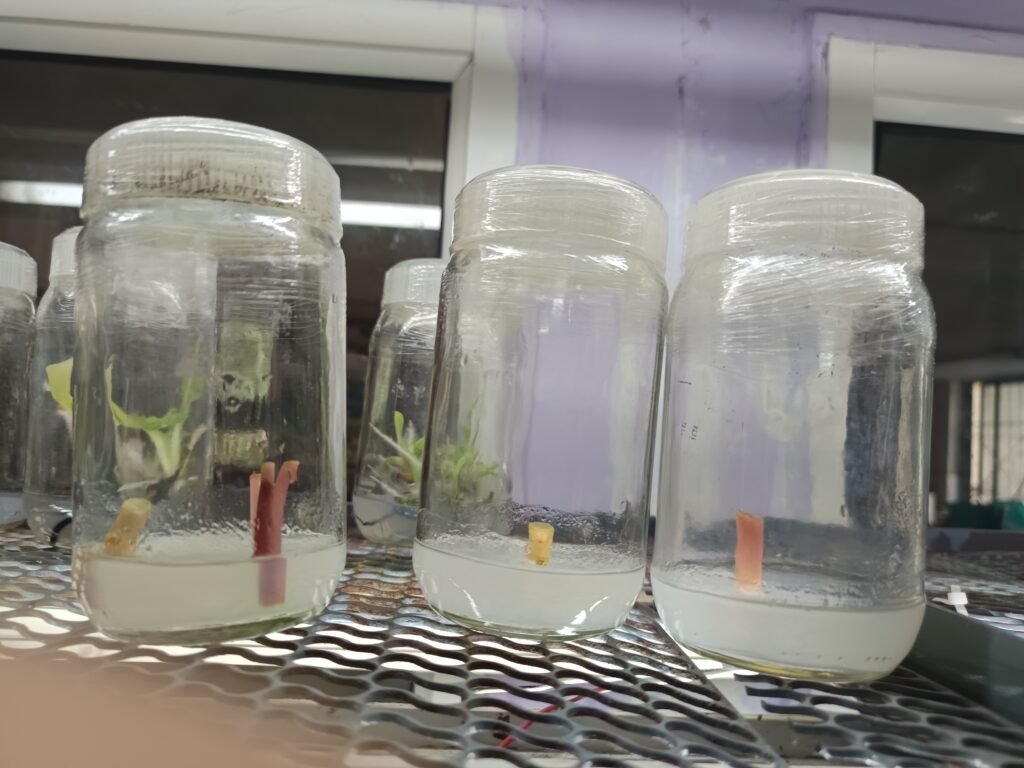
RESULT :-
Three bottles of Aglaonema plants got contaminated in 14 days.
27 August 2025
I took the Aglaonema plant, did its surface sterilization, and inoculated it into MS medium.
Result :-
Six bottles of Aglaonema plants got contaminated in 16 days.
31 August 2025
After taking the Aglaonema plant, I sterilized its surface and inoculated it into MS medium.

Result :-
Two bottles of Aglaonema plants got contaminated in 10 days.
2 September 2025
I again took Aglaonema plants from the hydroponic setup, did its surface sterilization, and then inoculated it into the culture bottle.
Result :-
Aglaonema plants got contaminated in 15 days.

5 September 2025
I took the Aglaonema plant, did its surface sterilization, and inoculated it into MS medium.
Result :-
Again aglaonema plants got contaminated in 15 days.
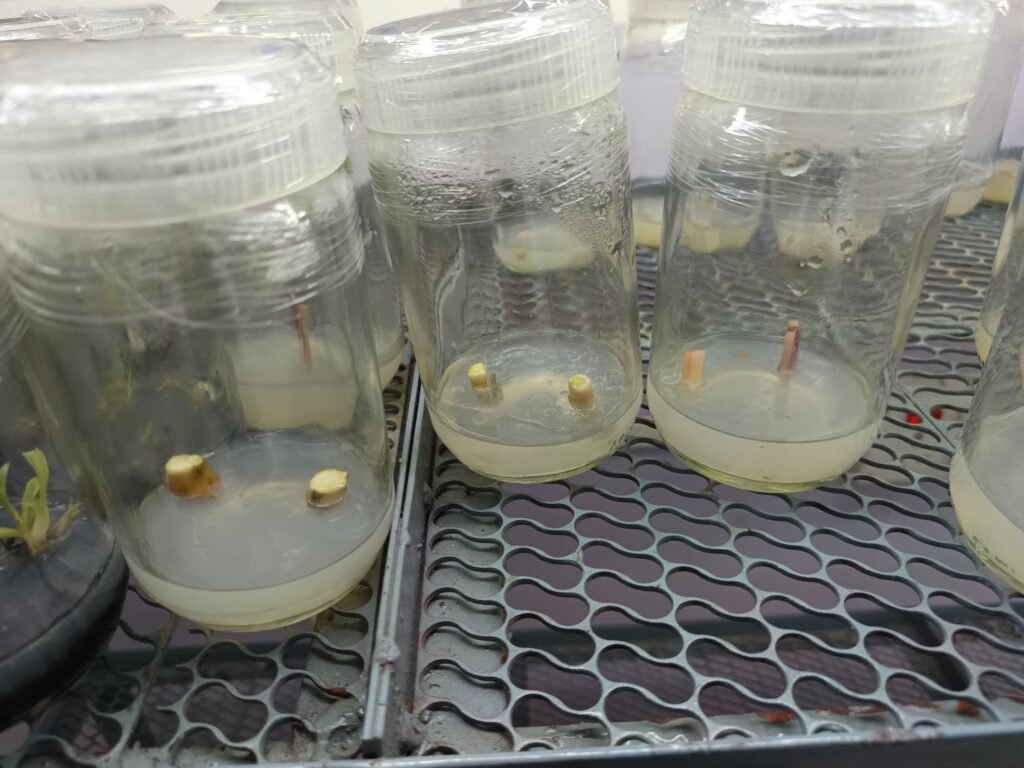
6 September 2025
I took two bottles of Aglaonema plants that were already inoculated, soaked them in sodium hypochlorite solution for 30 minutes on the 24th, then washed them 3 to 5 times, soaked them in antibiotics solution for 30 minutes, and then inoculated them into the medium.
I took the Aglaonema plant, did its surface sterilization, and inoculated it into MS medium.
Result :-
After one week inoculation aglaonema got contaminated.
8 September 2025

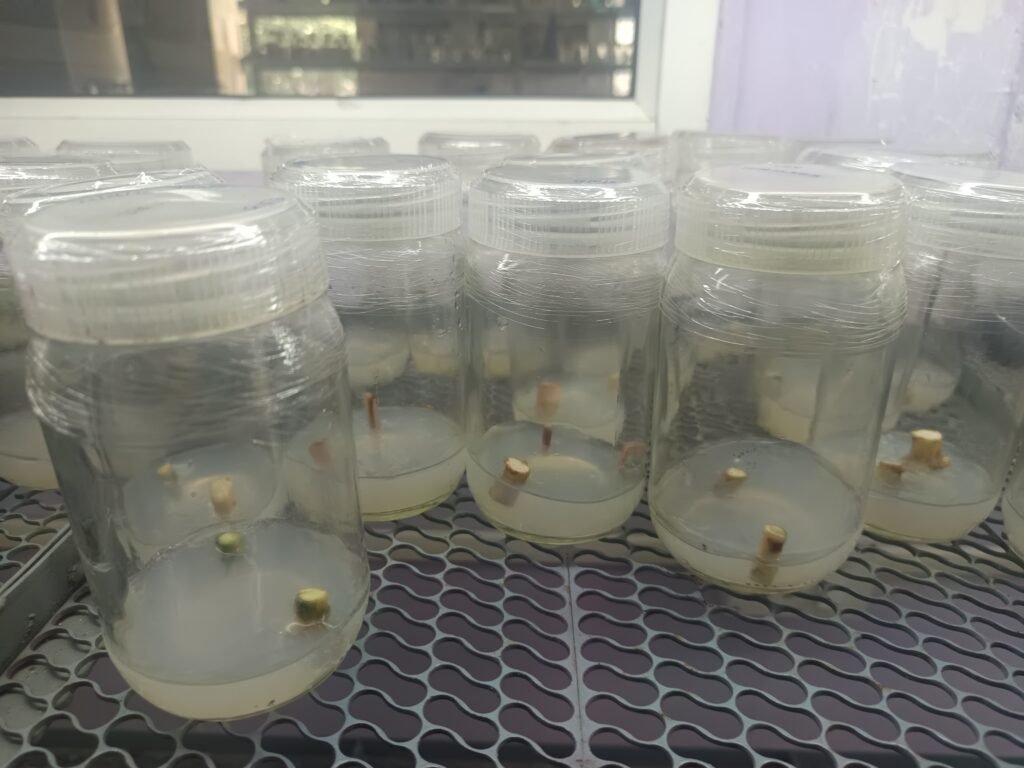
10 September 2025
I again discussed the contamination problem in Napier plants with Dixit Sir. He suggested that the Aglaonema plants grown in hydroponics should be washed with 1% sodium hypochlorite solution, treated with calcium hypochlorite, the water should be dosed and changed daily, and UV light should be used in the hydroponic setup.
12 September 2025
I took the Aglaonema plant, did its surface sterilization, and inoculated it into MS medium.

Result :-
Aglaonema plants got contaminated in 14 days.
14 September 2025
I took Aglaonema plants that were treated with calcium hypochlorite, then performed surface sterilization and inoculated them.
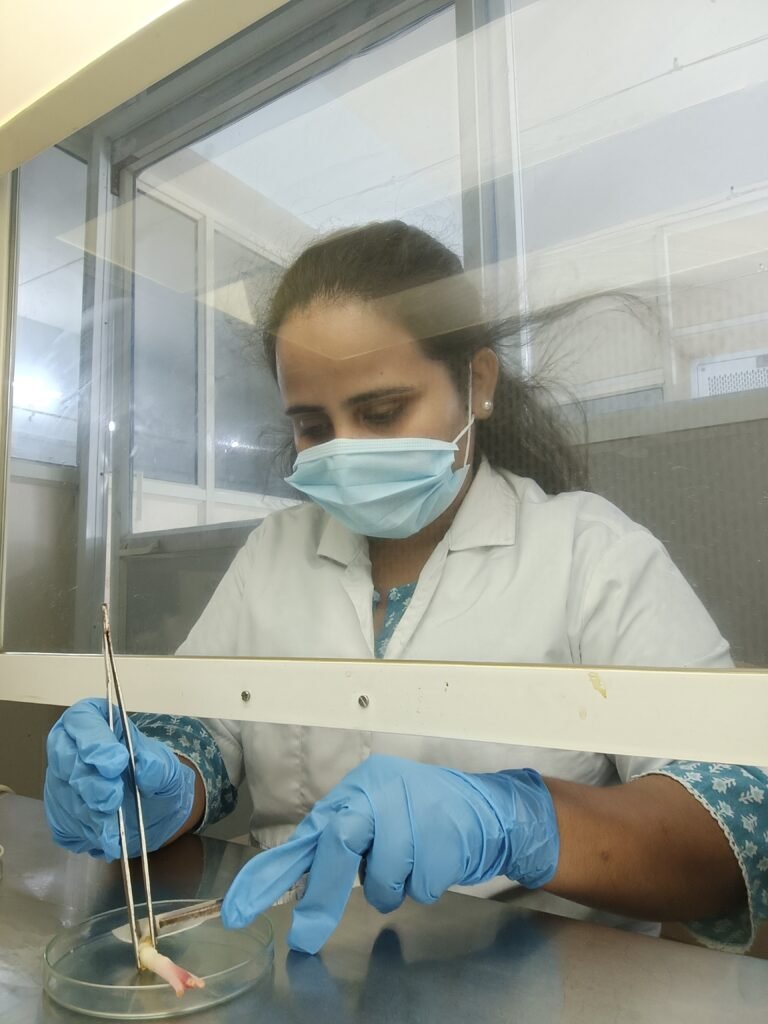
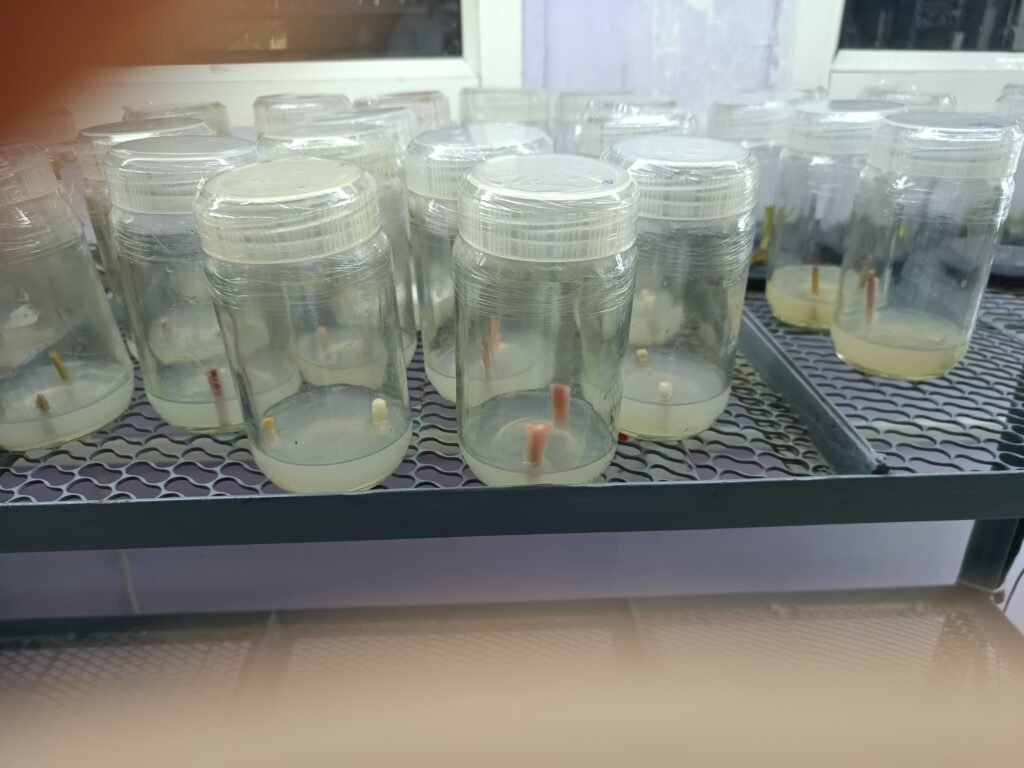
Result :-
Plants again got Contamination in15 days.
16 September 2025
SUBCULTURING :-
I transferred Aglaonema plants from the first stage to the second stage, using hormone media for this. There are a total of 4 plants in the second stage.
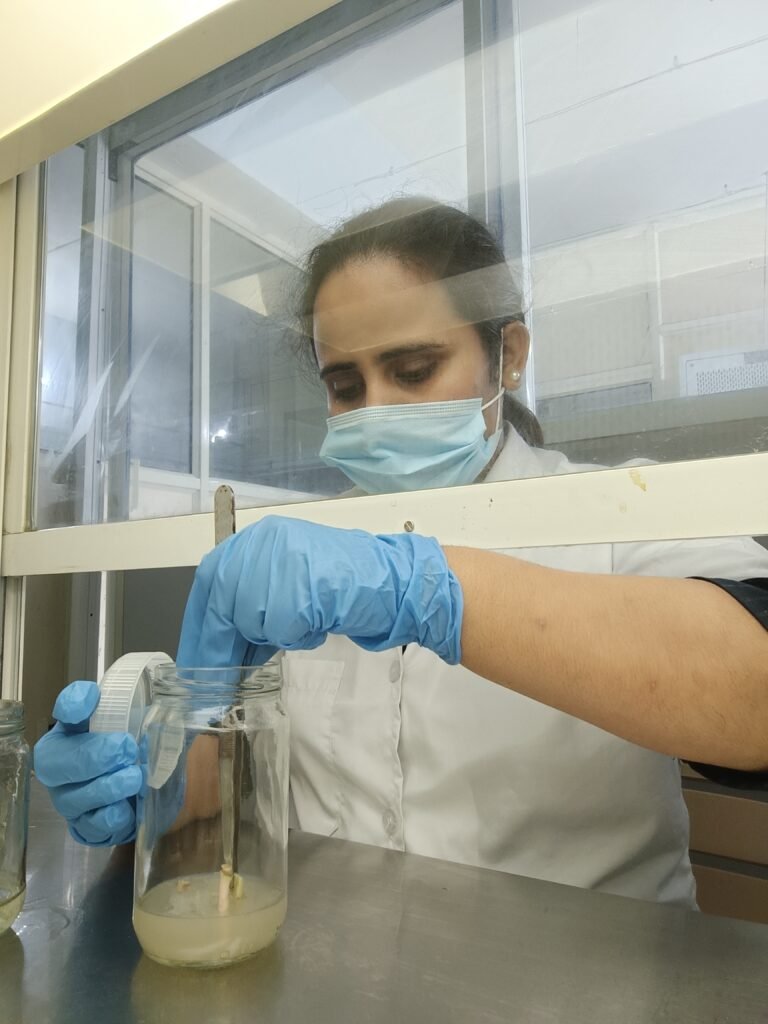
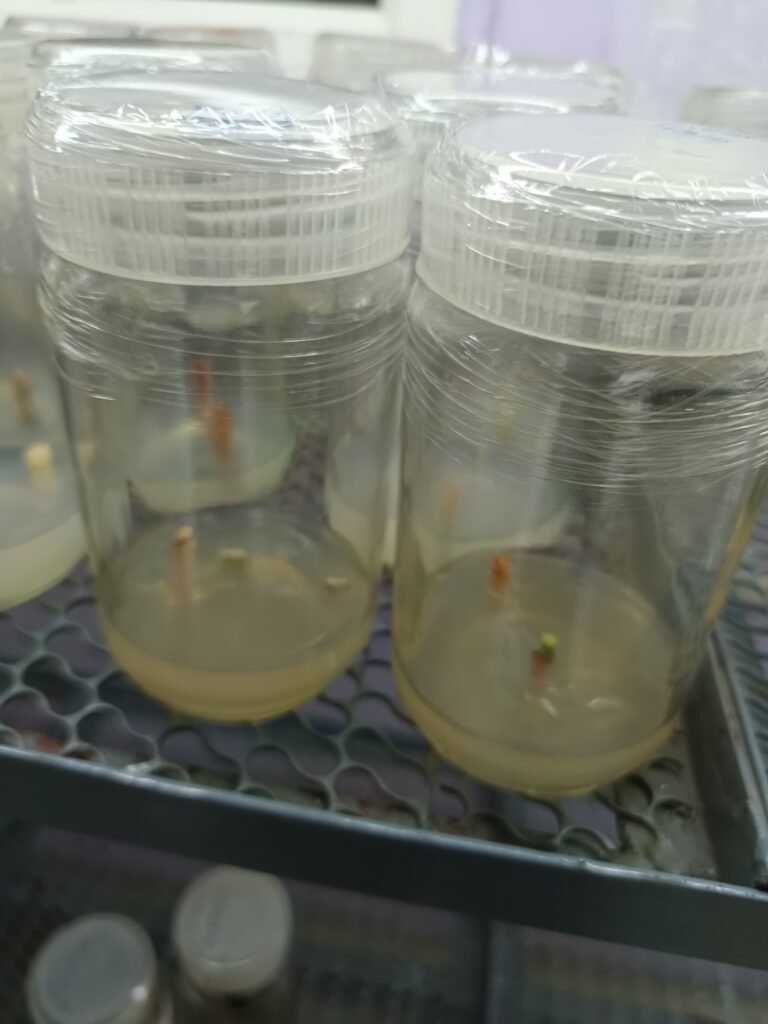
Result :-
In second stage aglaonema plants got contaminated in 8 days.
19 September 2025
I took Aglaonema plants that were treated with calcium hypochlorite in a hydroponic setup, then cleaned the surface and planted them.
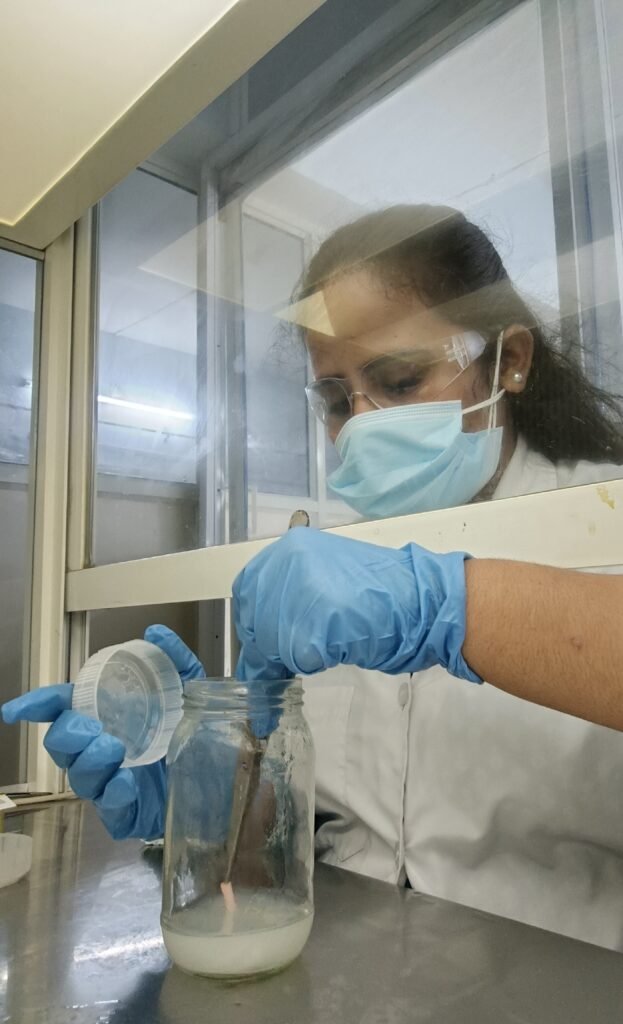

Result :-
Aglaonema plants got contaminated in 15 days.
22 September 2025
I took the Aglaonema plant, did its surface sterilization, and inoculated it into MS medium.
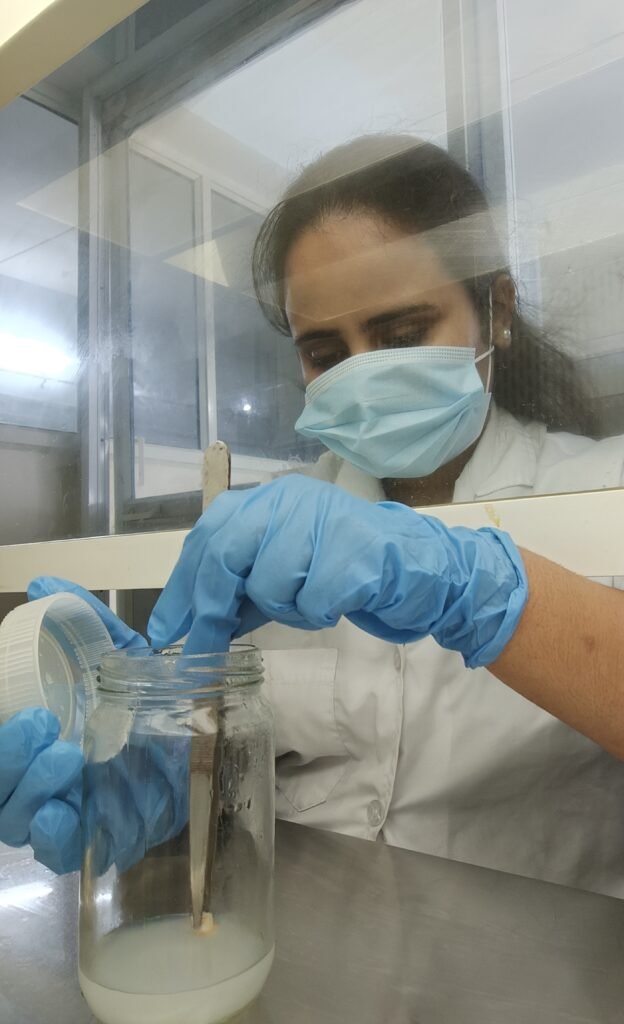
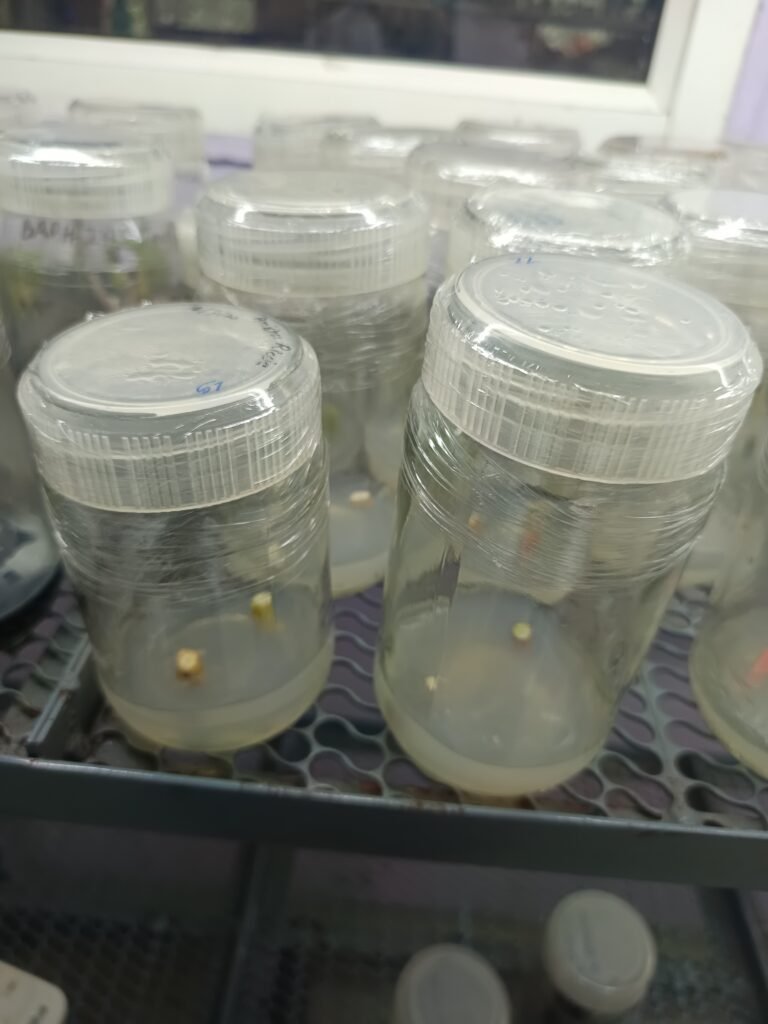
24 September 2025
I took Aglaonema plants that were treated with calcium hypochlorite in a hydroponic setup, then cleaned the surface and planted them.
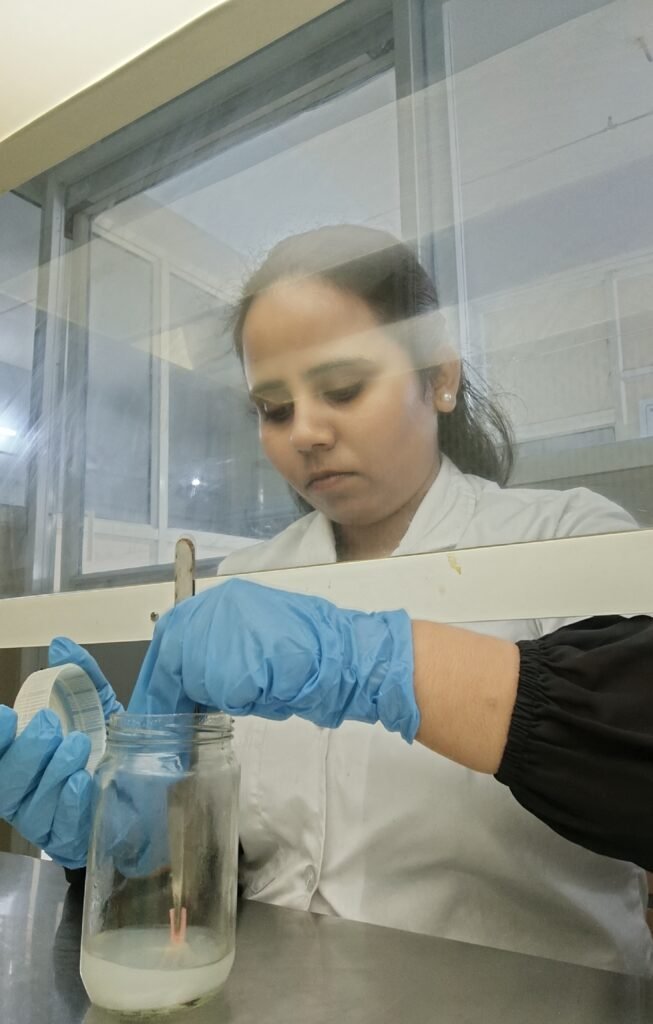

27 September 2025
I took Aglaonema plants that were treated with calcium hypochlorite, then performed surface sterilization and inoculated them.

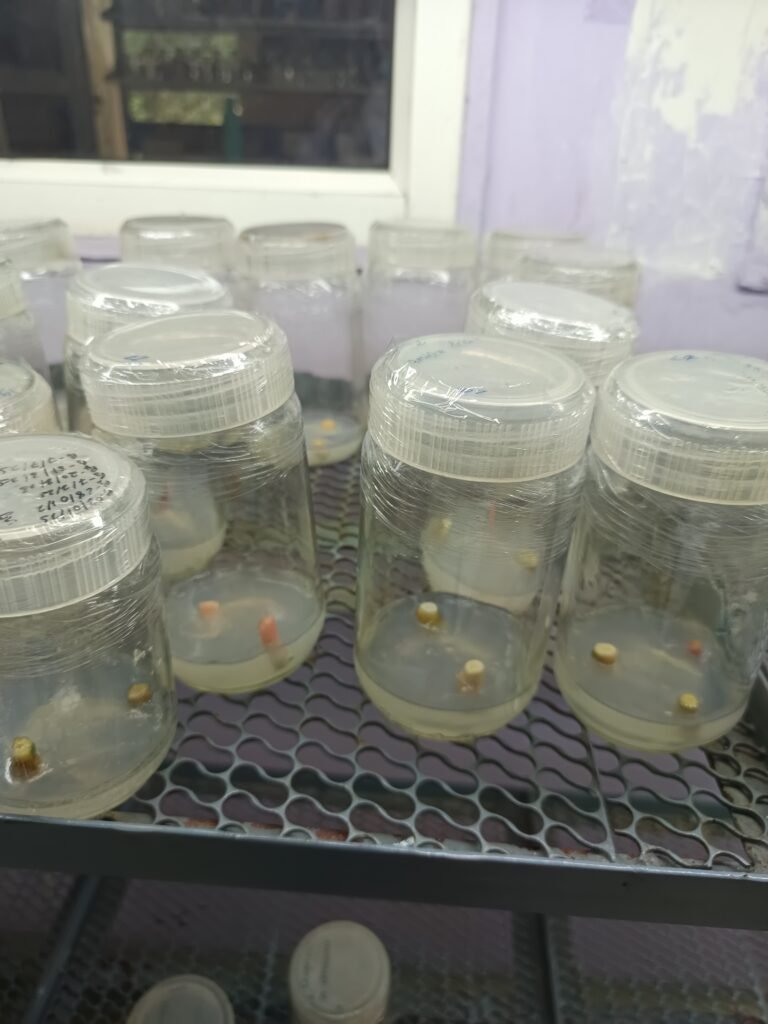
1 October 2025
I took the Aglaonema plant, did its surface sterilization, and inoculated it into MS medium.

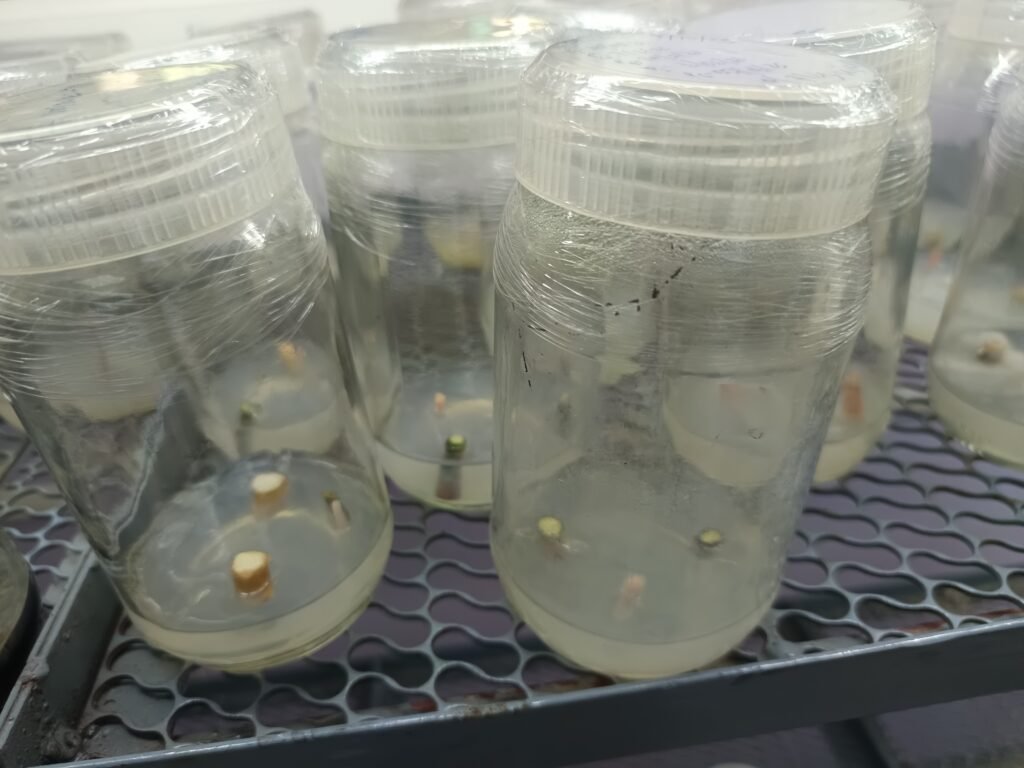
4 October 2025
Some effects appeared on the plants, so the calcium hypochlorite quantity was reduced from 5 g to 2.5 g.
I took Aglaonema plants that were treated with calcium hypochlorite, then performed surface sterilization and inoculated them.
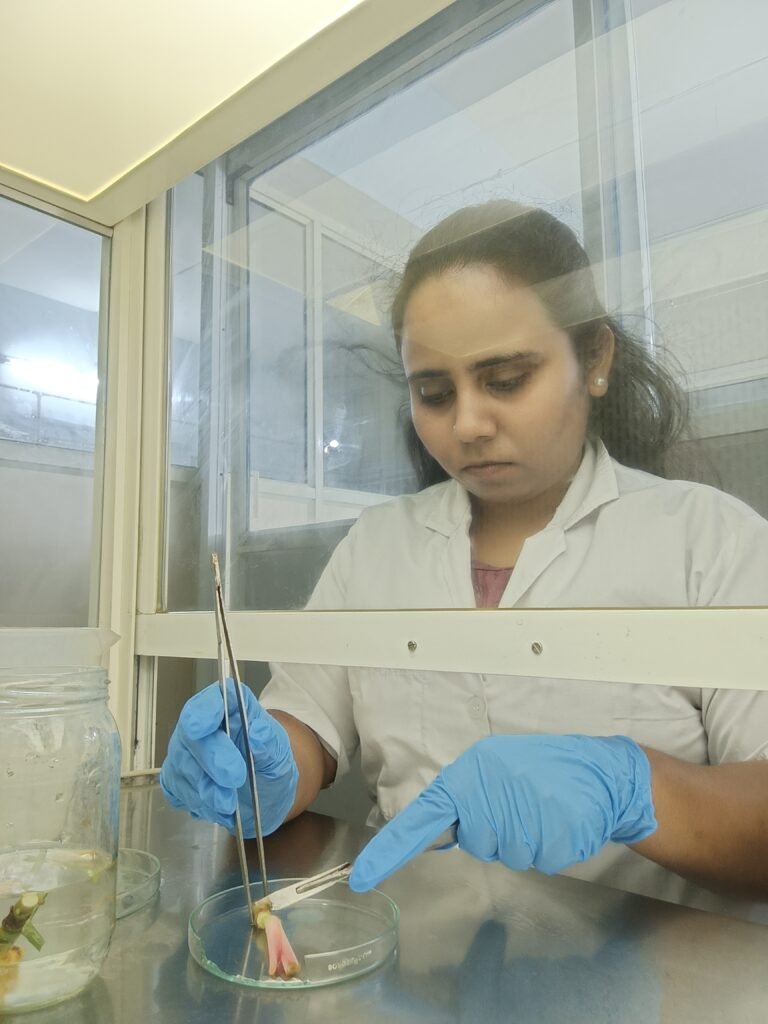
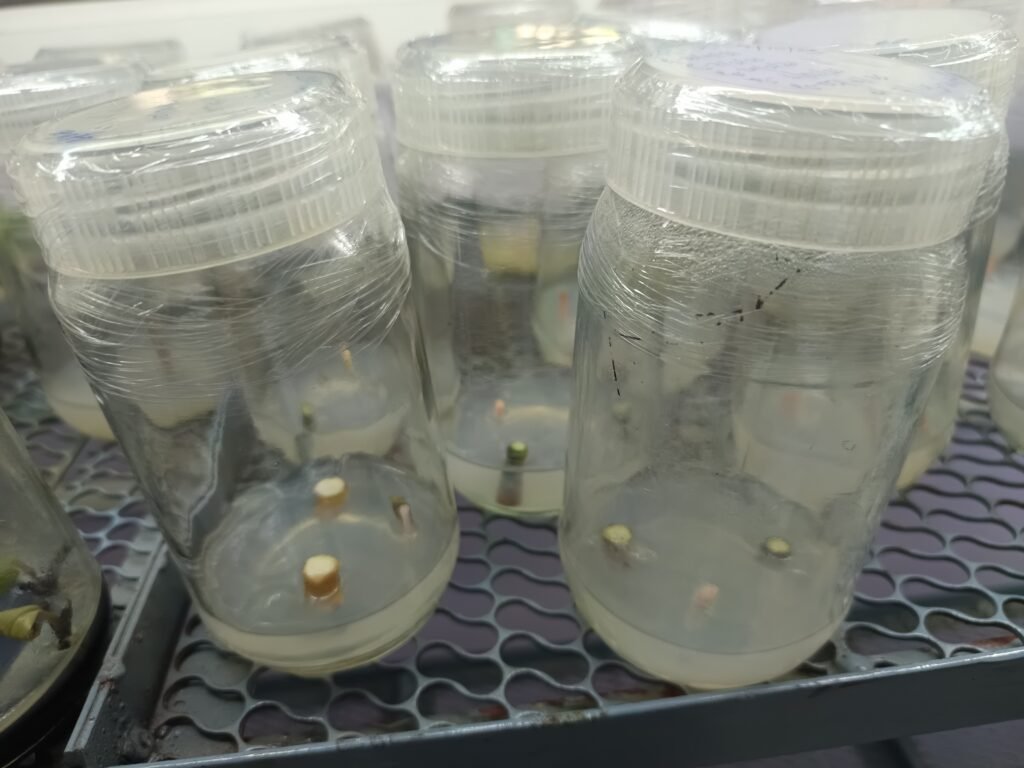
6 October 2025
I took Aglaonema plants that were treated with calcium hypochlorite in a hydroponic setup, then cleaned the surface and planted them.
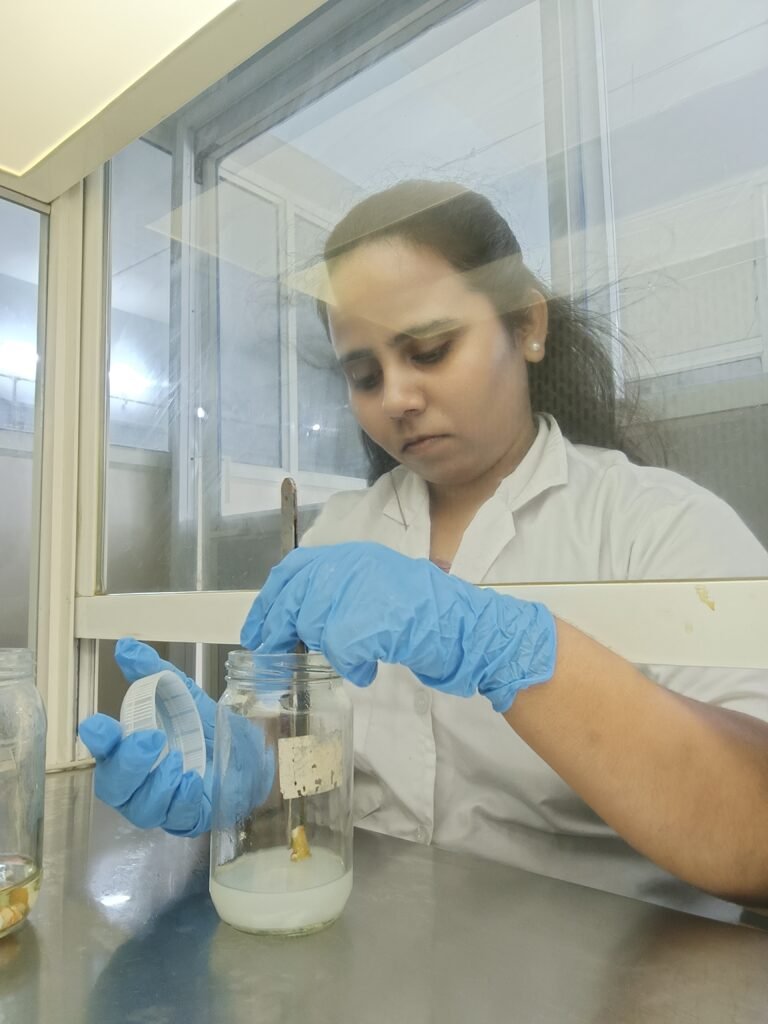
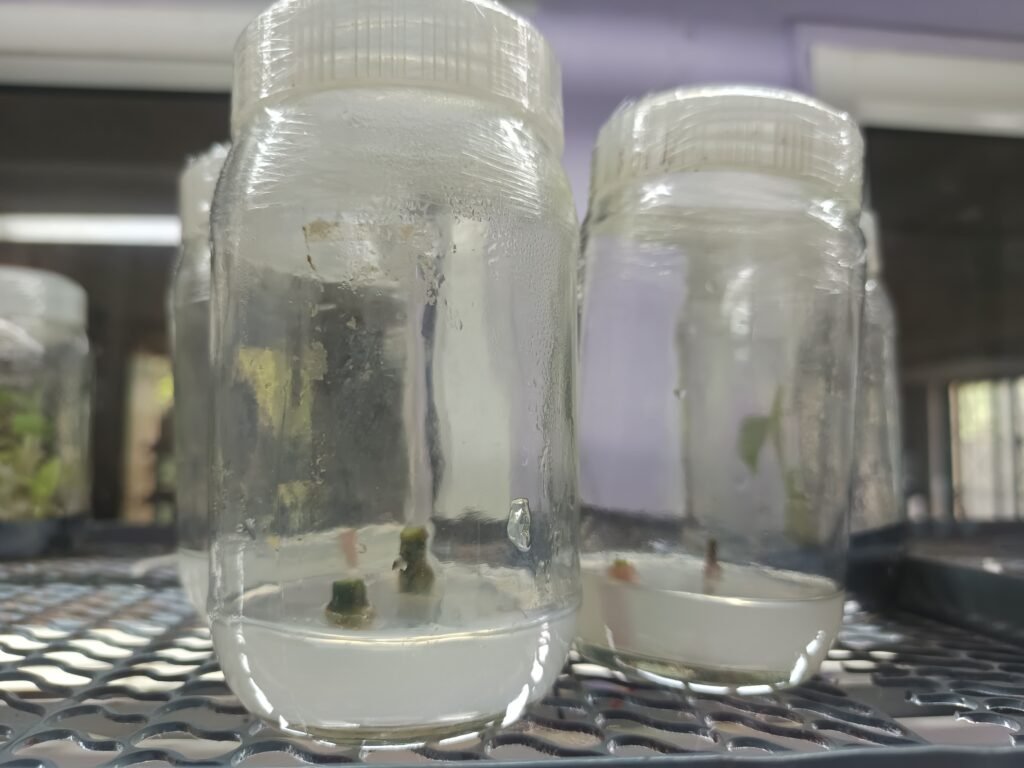
10 October 2025
I took the Aglaonema plant, did its surface sterilization, and inoculated it into MS medium.
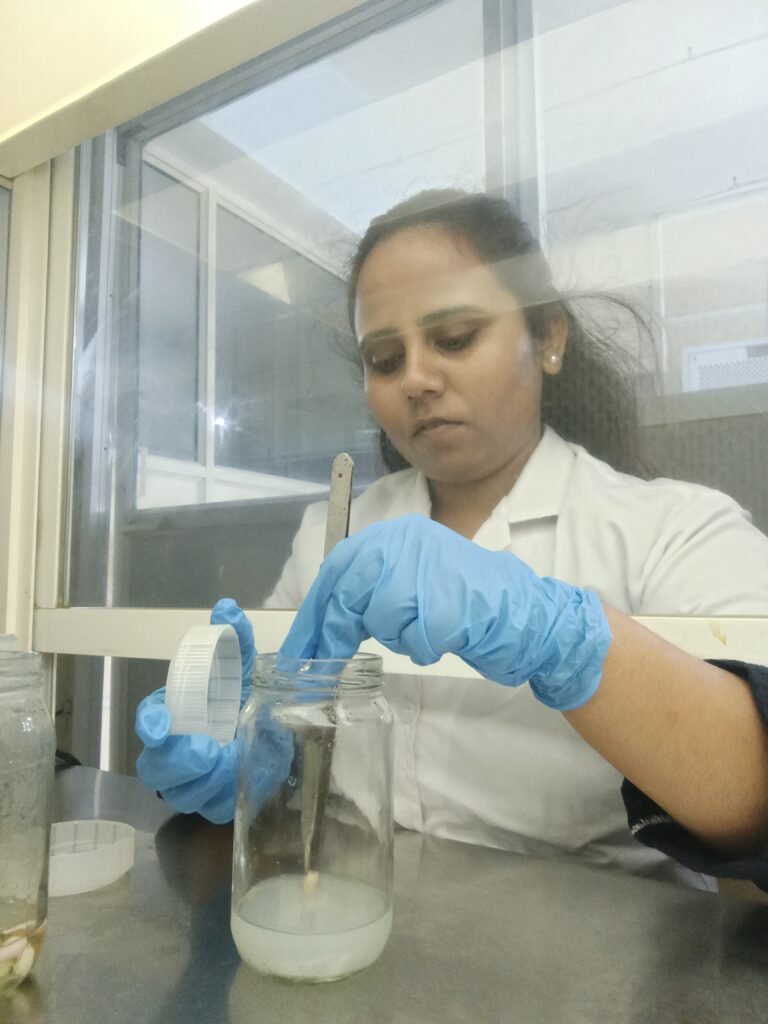

October 2025

